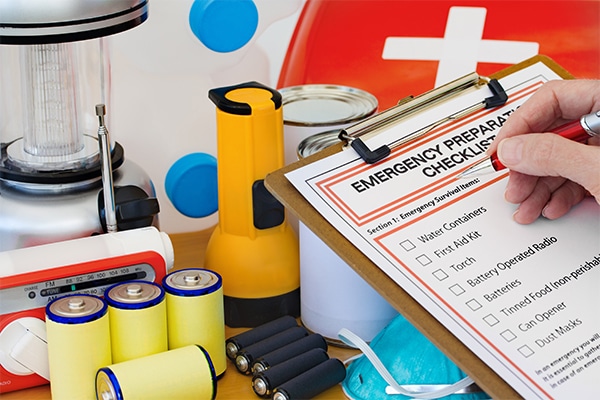What to Put in an Emergency Kit

In addition to protecting your loved ones with a security system, it’s a good idea to consider how to protect them from other unexpected incidents such as natural disasters.
The best way to prepare for a massive power outage (most often caused by a natural disaster) is to build an emergency kit.
Here’s how:
Consider how many people (and animals) your survival kit will need to support and what their specific needs are. For example, what kind of emergency are you expecting? Does the emergency typically require you to stay in place (at home) or would you possibly need to evacuate? If you think there’s an evacuation possibility, you may want to consider creating a portable survival kit that you can easily throw in your car.
The Essentials for an Emergency Kit
Water: You don’t want to get caught without a clean water supply. Plan on having at least one gallon of water on hand per person per day, for drinking, bathing, and cleaning. You can purchase gallons of purified water at a grocery store or reuse empty juice bottles and fill them with tap water.
Food: When an emergency shuts down the power grid, it also shuts down most grocery stores and restaurants. Be prepared with energy bars, beef jerky, nuts, and dried fruit. You can also add a can opener and include canned foods like soup and vegetables. Don’t forget baby food and pet food if needed. For easy clean-up, include paper plates and plastic-ware.
Information and Light: During a disaster situation, you can’t rely on local news, internet, and mobile phones for updates and information. We suggest adding a weather radio to your kit to stay informed of changes in weather, evacuations, and other important information. Many weather radios also include lights and cellphone chargers, reducing the number of electronics you’ll have to keep in your kit.
It’s also important to also have batteries and flashlights handy.
First Aid: Your emergency kit should include a variety of first aid items such as bandages, gauze, antibiotic ointment, and pain medications. You can also include items like burn cream, elastic bandages, allergy medicine, tourniquets, and other first aid items. Experts suggest putting items in waterproof containers so they stay dry and ready to use.
Shelter and Clothing: Every emergency kit should include at least one extra set of clothes and a blanket for each person. It’s also a good idea to include a waterproof tarp if you need to camp out in the elements.
Comfort and Cleanliness: While it may be low priority, you can’t underestimate the reassuring effects of cleanliness and comfort when you’re under stress. Include personal hygiene items, baby wipes, and garbage bags on hand to keep everyone feeling their best and to avoid sickness that can come from unsanitary conditions.
Important Documents: While it’s not necessary to include these items before an emergency strikes, it’s a good idea to throw them in if and when you have to evacuate.
- Insurance
- Passports
- Birth certificates
- Cash
- Other documents necessary
Tips:
- Plan for a minimum of three days of survival.
- Store your kit in a large water-proof storage tub is a good option for most kits. It keeps everything in one place and it’s fairly easy to move if you have to evacuate. For mobile and smaller kits, use a in case you have to grab essentials from your kit and go.
- Store your kit in a climate-controlled environment (so food doesn’t spoil) where you can access it easily.
Learn more at ready.gov.
